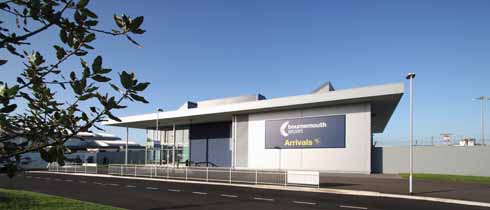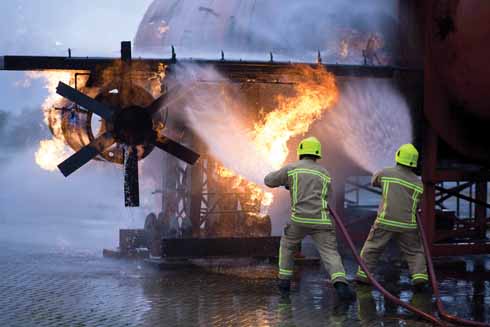A day in the life of Bournemouth Airport
An ambitious redevelopment scheme has transformed Bournemouth Airport, but it remains a small, busy regional airport. John Newth paints a picture of it at work across 24 hours.
Published in January ’12
5 am. The first flight of the day disappears into the lightening sky, carrying the first editions of the London newspapers to the Channel Islands. The check-in desks for the 7 am Thomson flight to Ibiza have already been open for half an hour. It is one of ten passenger flights leaving the airport today. At the check-in desk, passengers’ tickets and passports are examined, their luggage is weighed and anyone is checked in who has not already checked themselves in on-line. More and more people are choosing to use the alternative of an on-line facility; for some airlines like Ryanair, it is the only way that passengers can check in.
6 am. Nick Dardani of the Aerodrome Safety Team makes a circuit of the runways checking for any problems and to scare birds away ahead of a take-off. He watches anxiously as a skein of geese circles the airfield then hits a switch on his vehicle’s dashboard to cause a powerful speaker to emit rook-scaring noises to clear several dozen lazily flapping birds from next to the runway. Lapwings are also a surprisingly common sight at the airport as, take-off and landing noises aside, it is a safe location for them. The team has been experimenting with mowing the grass to different lengths to dissuade the lapwings from roosting by the runways overnight.
7 am. Despatcher Michelle Alexyova watches the Thomson flight to Ibiza push back from its stand.
For the last hour or so, she has been responsible for all liaison between the flight and cabin crews and the airport services. It is a demanding job: she and her colleagues carry the immediate responsibility for every flight’s safe and punctual departure.
8 am. A Falcon jet belonging to Cobham takes off on its way to duties with a Royal Navy training exercise in the Channel. The company, which was founded by aviation pioneer Alan Cobham, has a major presence at the airport, with which it has been associated since RAF Hurn (opened in 1941) became a civil aerodrome at the end of the War.

Bags checked, a couple on their way to Tenerife leaves the check-in desk manned by the ever-smiling Dawn Rogers
9 am. The senior management team is holding its fortnightly meeting in the office of Rob Goldsmith, the airport’s Managing Director. He was part of the courageous decision to press on with the redevelopment even when the recession began to
bite. For the last four years the building works have been the major topic for discussion but the emphasis has now shifted to exploiting the advantages the new facilities will give the airport as the market recovers.
10 am. The first arrival of the day touches down: a Ryanair flight from Tenerife. It will be on the ground for barely half an hour, so there is pressure on staff to complete the turnaround as quickly as possible. The incoming passengers are ushered into the new arrivals hall that is part of the airport’s recent £45 million redevelopment. The terminal is designed to be carbon-neutral and is a no-frills building: arriving passengers just want to pick up their bags and go, and most of them will be off the airport within forty minutes of their plane landing.
11 am. A passenger on the 12.40 pm Ryanair flight to Pisa tells Dawn Rogers, manning the desk, that he is looking forward to a coffee in the restaurant in the new departures terminal. He is horrified when Dawn points out that he has picked up his wife’s passport instead of his own. He lives north of Wimborne: can he drive home, pick up his passport and get back before check-in closes at noon? He reckons he can and dashes out of the terminal. Meanwhile, other passengers on the flight head through security – a process which is targeted to take no more than twelve minutes, even at the busiest times – and into the departure lounge. The departures terminal is a new building, constructed around the former terminal, but has a much greater feeling of light and spaciousness than its predecessor, while retaining its air of relaxed intimacy.
12 noon. The passenger who had the wrong passport pants up to Dawn Rogers’s desk, having made it with a few minutes to spare. Particularly with Ryanair’s tight schedule, there can be little flexibility in the rule that check-in closes forty minutes before a flight’s departure.

The pilot and co-pilot of a Thomson flight crew prepare their aircraft for a take-off from Bournemouth Airport
2 pm. Greg Fanos, the Deputy Air Traffic Services Manager, is in charge of the new shift in the control tower and allocates people to the various positions from which they control not only the aircraft within forty miles of the airport up to a height of 10,000 feet, but also the many ground vehicles that dash about their business on the twelve miles of tarmac on the airfield. Each controller has to take a half-hour break every two hours, so it is like a chess game to ensure that all functions are covered at all times. Alongside the redevelopment, the tower was provided with highly sophisticated radar which gives detailed information about every aircraft on the plot. Another element of the project was the installation of a modern automatic landing system which enables suitably equipped aircraft to use the airport even in very poor visibility.
3 pm. Rob Goldsmith receives a delegation of senior executives from a tour company who have just been on an extensive inspection of the airport because they are thinking of using Bournemouth for a number of their flights in 2013. Rob conveys to them his passionate belief in the airport’s potential, given its efficient but attractive facilities and its large, affluent catchment area. After they have gone, he reviews the papers for an important meeting he must attend in Manchester tomorrow with the airport’s owners, Manchester Airport Group.
4 pm. In a far corner of the airfield, the fire service is carrying out a training exercise under the Deputy Senior Airport Fire Officer, Keith Jewitt. They are practising in the purpose-built fire training simulator which can replicate the types of commercial aircraft most commonly seen at Bournemouth. Keith is keeping a close eye on two new recruits, one of whom is finding it tough going as he scrambles up a ladder while laden with full firefighting gear and breathing equipment. Physical fitness is essential to a firefighter and is tested twice a year; the fire station includes a fully equipped gym. The airport’s fire service works closely with Dorset Fire and Rescue, and for this exercise they have been joined by colleagues from Christchurch fire station.
5 pm. It is a peaceful evening scene as a gang mower completes a day of cutting some of the 400 acres of grass. Then a twin-engined plane with six people on board, en route from Birmingham to Jersey, calls the tower because a warning light has come on, suggesting that there is a problem with the hydraulics. The pilot is twenty miles to the north of the airport and asks for permission to make an emergency landing. Greg Fanos immediately orders all other landings and take-offs to be suspended and contacts the fire service. Keith Jewitt despatches two fire appliances at full speed to pre-determined standby points. Anxious eyes watch the plane as its lights appear in the eastern sky. However, it lands safely and the fire appliances follow it as it taxis to the apron for inspection by engineers.
6 pm. Three flying schools use the airport, which makes air traffic control (which is managed in house, rather than by NATS) somewhat more complicated than at airports where all the aircraft are of similar types and approaching and departing at the same speed. Air Traffic Controller Ellen Powell has to juggle commercial passenger jets and single-engined craft, whose pilots might be making their first landing.

Air traffic controller Ellen Powell and her collegues schedule the landings and arrivals of aircraft from small single seaters to substantial commercial passenger jets
8 pm. Mike Porto is in charge of every aspect of the day-to-day operational engineering and maintenance, from broken windows and blocked drains to the recent resurfacing of the runway as yet another part of the redevelopment. The runway is 1.4 miles long, one
of the longest in the South, so it can take the largest planes and Bournemouth is a favoured diversion airport if Heathrow or Gatwick should be closed for any reason. However, it also meant that the resurfacing was a huge project, involving a hundred men and fifty machines working overnight for two months. Now his department’s automatic sweepers are out; they sweep every inch of runway, taxiway and service road every two weeks.
11 pm. A mail flight takes off for East Midlands Airport, from where the mail will continue its journey to the North and Scotland. Cleaners are busy in the departures terminal, now empty of the bustle of passengers looking forward to their journeys. Lights still burn in the control tower and the fire station, both of which will be manned all night.





